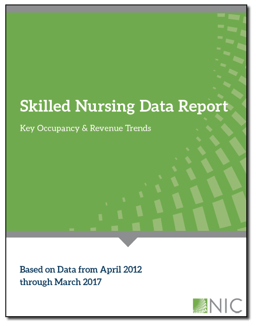NIC has just released its first quarter 2017 Skilled Nursing Data Report, which includes key monthly data points from April 2012 through March 2017.
The current report is based on data collected monthly, but reported quarterly, from approximately 20 operators and 1,500 properties. While NIC continues to add more operators and properties to the data set with the goal of producing state-level reports, this data represents national, aggregate figures. NIC welcomes the participation of operators nationwide in this confidential data collection process. Participants will receive a free benchmark report every month for their contribution.

Here are the key takeaways from the report:
- Occupancy increased 36 basis points from last quarter to 82.6% demonstrating the expected seasonality as the first quarter usually sees an uptick from the fourth quarter. However, occupancy decreased from the month of February after exceeding 83% for the first time in eight months. Occupancy has not exceeded 84% since March of last year, and hasn’t reached 85% since April 2015. Over the past three 12-month periods, average occupancy declined from 85.7%, to 84.3%, and most recently falling to 82.9%. If occupancy continues at this rate of decline year-over-year, a new low will be expected later in 2017.
- Private revenue per patient day (RPPD) rose by 1.5% on a quarter-over-quarter basis and by 2.7% year-over-year. Although most of the decline in private day mix occurred in the last quarter, the yearly increase may not be strong enough to offset the decline in private patient day mix, which has fallen year-over-year by 62 basis points. Private RPPD is one way operators can mitigate revenue loss from decreased occupancy and skilled mix, which may help to explain why the private RPPD has increased in recent quarters.
- Managed Medicare patient day mix reached its highest point within this time-series in the month of February. It increased on a quarter-over-quarter and year-over-year basis, mirroring the trend in managed Medicare seen in the first quarter of 2015, which endured a relatively significant flu season. All three months of the first quarter were among the top 10 months for managed Medicare patient day mix within the data series. Quarter-over-quarter, managed Medicare RPPD increased, marking it the first time in two years that managed Medicare RPPD increased on a quarter-over-quarter basis. The increase, while subtle, suggests a reversal from what had been a rapid decline in the managed Medicare RPPD.
- The uptick in Medicare and Managed Medicare patient day mix were the drivers behind increased quality and skilled mix in the first quarter, which is not unexpected in terms of seasonality and which may have been heightened by a relatively more significant flu season. Despite this recent increase, the average Medicare mix for the last 12 months decreased by 116 basis points compared to the average for the previous 12-month period (April 2015 to March 2016). In addition, the average Medicare mix for the previous 12-month period decreased by 99 basis points from the average for the 2014-2015 period, following the same trend as overall occupancy.
Stay tuned for a detailed article about the data in the next NIC Insider.
NIC released its latest Skilled Nursing Data Report on June 8, 2017. You can download the latest report and future report here.
About Bill Kauffman
Senior Principal Bill Kauffman works with the research team in providing research and analysis in various areas including sales transactions and skilled nursing. He has lead roles in creating new and enhanced products and implementation of new processes. Prior to joining NIC he worked at Shelter Development in investing/acquiring, financing, and asset management for over $1 billion in assets. He also had key roles in the value creation and strategic planning and analysis for over 65 entities. He received his Bachelor of Business Administration in Finance from the College of Business and Economics at Radford University and his Master of Science in Finance from Loyola College in Maryland. He also holds the Chartered Financial Analyst Designation (CFA).
Connect with Bill Kauffman
Read More by Bill Kauffman